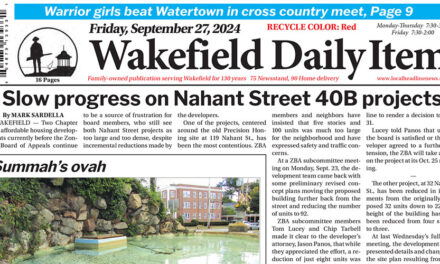By MARK SARDELLA
WAKEFIELD — Two Chapter 40B affordable housing developments currently before the Zoning Board of Appeals continue to be a source of frustration for board members, who still see both Nahant Street projects as too large and too dense, despite incremental reductions made by the developers.
One of the projects, centered around the old Precision Honing site at 119 Nahant St., has been the most contentious. ZBA members and neighbors have insisted that five stories and 100 units was much too large for the neighborhood and have expressed safety and traffic concerns.
At a ZBA subcommittee meeting on Monday, Sept. 23, the development team came back with some preliminary revised concept plans moving the proposed building further back from the street and reducing the number of units to 92.
ZBA subcommittee members Tom Lucey and Chip Tarbell made it clear to the developer’s attorney, Jason Panos, that while they appreciated the effort, a reduction of just eight units was not going to be sufficient to address the board’s concerns. They asked Panos to go back to the owner convey the message that the ZBA was seeking a “significant” reduction in density.
Panos agreed to do that and he also extended the board’s deadline to render a decision to Oct. 31.
Lucey told Panos that unless the board is satisfied or the developer agreed to a further extension, the ZBA will take a vote on the project at its Oct. 25 meeting.
—
The other project, at 32 Nahant St., has been reduced in increments from the originally proposed 32 units down to 22. The height of the building has also been reduced from four stories to three.
At last Wednesday’s full ZBA meeting, the development team presented details and changes to the site plan resulting from the latest reduction in size from 24 to 22 units.
But board members said that the proposed building was still too big for the neighborhood and a reduction of two units was not sufficient to address the board’s concerns about size and traffic.
Board member Chip Tarbell asked the development team if they had considered moving the building further back off the street. The project engineer and architect said that they had looked at different positioning of the building on the site, but none of those seemed to work.
In terms of the building size and density, attorney Paul Haverty said that 22 units was as low as his client, developer Scott Green, could go and still make the project economically feasible.
But when board members insisted that the project was still too big, Haverty said that if the board were to deny the project, he would take it to the state Housing Appeals Committee and seek approval for a bigger project.
When ZBA Chairman Tom Lucey suggested that Haverty was “trying to put a gun to our head” by mentioning an appeal, Haverty denied that was his intention. He reminded the board that the developer was trying to work with the board and had already reduced the size of the project by 30 percent.
Board members pointed out that despite the reductions there was still almost no useable green space on the site.
Tarbell suggested assigning one member of the ZBA to work offline with the development team to see if there was some way to make the project more acceptable to the board.
Lucey was open to the idea, noting that the Traffic Advisory Committee would need time to review the latest plan revision anyway. Haverty said that he was also open to having further discussions. He agreed to extend the board’s deadline to render a decision to Oct. 31.
When the hearing was opened to the public, Karen McMaster of Nahant street said that even with the reduction the building was still too big.
“It just doesn’t belong here,” she said.
Kyla MacKay Smith, a direct abutter, maintained that the project would almost double the number of units on that section of Nahant Street.
Joanne Bonfiglio of Kathleen Drive expressed ongoing concerns about traffic safety on Nahant Street.
The ZBA continued the hearing to Oct. 9.





